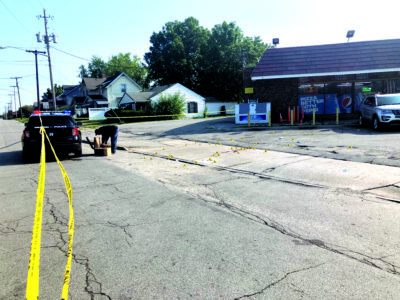State’s plan to demolish Austintown bridge draws opposition
By DAN POMPILI
Staff writer
AUSTINTOWN — A state plan to demolish a local bridge has township officials concerned about public safety.
Trustee Robert Santos said the township’s administrators oppose ODOT’s proposed demolition of the Lanterman Road bridge over Interstate 680 in the northeast corner of the township because it will extend emergency service response times.
“Fire and police are against it, and so is the entire board of trustees. It will definitely be detrimental to the township and the safety of our residents,” he said. “They have taken the humanity out of everything. This is completely wrong, and I hope they would work with us to find a sensible solution.”
Santos said the plan was originally proposed in 2019, but he suspects it was shelved along with many other projects during the COVID-19 pandemic.
Santos became aware of it when he was running for election in 2021, he said, and trustees recently were made aware of ODOT’s plans to revive the project.
Fire Chief David Schertzer and police Chief Robert Gavalier echoed the concerns of Santos. When the plan was first proposed in 2019, Scherzter said, then-fire Chief Andy Frost attended a public meeting to support residents’ fears about safety response times.
Schertzer and Gavalier said they ran their own time test because they were unwilling to just accept ODOT’s assessment.
The main detour, in the event of the bridge’s demolition, would take traffic along Raccoon Road onto Crum Road, to Meridian Road, then up to Lanterman Road.
Running a truck from Station 2 at Wickliffe Circle — the closest station to the Lanterman Road neighborhood — and taking the adjusted route ODOT proposed, they found it would add 3:22 to their response to the closest house on the side of Lanterman that would be cut off.
Santos said the standard response time would increase from 4:31 to 7:53.
Schertzer and newly-appointed fire Capt. Brandon Wirtz, who heads the department’s EMS operations, said even seconds count and 3.5 minutes could be catastrophic.
“The general rule of thumb used to be that a fire doubles in size every minute,” Schertzer said. “But now it’s more like 30 seconds.”
He said that is because of the different types of materials found in homes today compared with what were found in homes built during and before the 1980s.
Wirtz said EMS response isn’t just about getting to a stroke or heart-attack patient, or even someone with a severed artery, in time to stop tissue or brain damage or halt bleeding.
“The faster we get things diagnosed, the faster they can activate resources at the hospital,” he said. “The hospital has that much more time to mobilize and it’s compounded, and leads to way better patient outcomes. Our goal is less than one hour from onset of symptoms to definitive care being administered. Those minutes really add up over the whole process.”
Gavalier said time is critical in crime response as well.
“If it’s a burglary in progress, we want to be there as soon as possible to try to catch them in the process, and with a domestic, those situations can go ugly real fast,” he said. “It’s a matter of getting there in time to stop the crime from happening or catching the perpetrators.”
He said it also compromises the safety of officers at a scene who may need backup quickly.
“If there’s no bridge, it makes it much worse. It’s going to be a disadvantage for our officers,” he said.
Santos said he spoke with an ODOT District 4 Environmental Specialist Sean Carpenter last week and was frustrated by the conversation.
He said Carpenter told him — as reflected in ODOT’s assessment — that response times would only lag by two minutes.
“It’s just a little disconcerting, when you read the assessment, I understand they have to save money, but when it comes to the safety and lives of our residents, it’s something we have to invest in,” he said. “It’s not as simple as it taking another two to three minutes to go get a gallon of milk.”
Santos added that in addition to the safety concerns, residents’ home insurance is likely to increase because of the lag in emergency response time.
He also said that once the project is completed, care of Lanterman Road — and all associated costs — would fall onto the township.
He said he told Carpenter that trustees wanted to meet with ODOT about the project but Carpenter declined, at least for the time being.
WHY DEMOLISH IT?
The assessment from ODOT shows that the bridge, built in 1967, was scheduled to be redecked.
“But upon further analysis the steel superstructure was found to fail in both the sheer and moment capacity,” the report reads. “Since the current structure fails in sheer over the center piers, coupled with the condition of the protective coating system…it is likely to be more cost effective to replace the entire superstructure.”
The report shows ODOT’s estimate of just over $2 million to replace the structure, and $4.2 million to replace and maintain it over its lifetime.
By contrast, removing the bridge and installing cul-de-sacs at the separation points in those neighborhoods will cost about $450,000.
District 4 spokesperson Ray Marsch said cost definitely is a factor, but ODOT has considered other aspects.
“The bridge…is nearing the end of its useful life. There are under 400 vehicles that travel this roadway every day,” he said. “There are various other options to cross I-680 in this area.”
As for Santos’ concerns about communication, Marsch said “ODOT has had and will continue to have ongoing conversations with Austintown Township about this project.”




